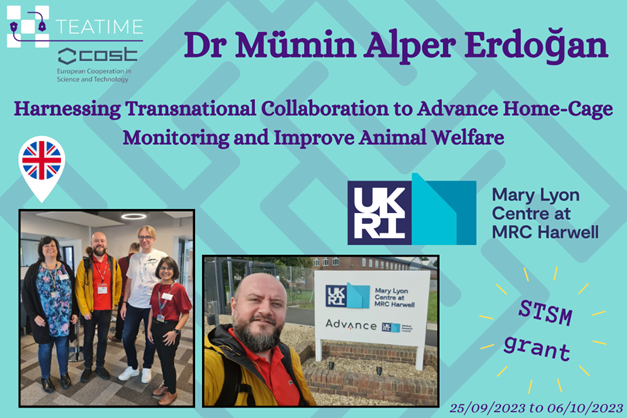
Details of the STSM
Title: Harnessing Transnational Collaboration to Advance Home-Cage Monitoring and Improve Animal Welfare
Start and end date: 25/09/2023 to 06/10/2023
Host: Mary Lyon Centre at MRC Harwell, Oxfordshire, England
Host website: https://www.har.mrc.ac.uk/
Description of the work carried out during the STSM
From September 25th to October 6th, 2023, under the guidance of Dr. Sonia Bains, I focused on evaluating Home Cage Monitoring (HCM) systems.
The STSM began with a brief presentation where I introduced myself and my work to the team. Subsequently, I was introduced to the Mary Lyon Centre (MLC) at MRC Harwell and got acquainted with their Home Cage Monitoring Labs. One of the practical sessions involved performing the Touchscreen Assay alongside a Senior Phenotyping Technician, granting me a hands-on experience with the procedure.
I dedicated a substantial portion of time to self-study, exploring different Home Cage Monitoring Systems through renowned online platforms like NC3Rs, UK. A significant component of this exploration was acquainting myself with the Experimental Design Assistant (EDA), a free online tool from the NC3Rs. The EDA is designed to guide researchers through their experiment designs, ensuring minimal animal use consistent with scientific objectives, reducing subjective bias, and promoting appropriate statistical analysis. My engagement with this platform was hands-on, and I utilized its features to conceptualize designs for my forthcoming projects. Alongside the EDA, I was also introduced to the Crackit platform, which gears towards the development of systems such as the HCA.
Taking the initiative, I set up my own Home Cage Model, capturing footage from front and back cameras to analyze maternal and pups’ behavior in the animal facility. This setup gave me a nuanced understanding of animal behavior monitoring in real-time.
Throughout the STSM, I was introduced to various facets of animal research. I became acquainted with animal models and the National Mouse Genetics Network (NMGN). The Data Management team at MRC offered insights into the downstream aspects of their workflows, and a dedicated meeting was held focusing on the 3Rs (Replacement, Reduction, and Refinement).
I had the opportunity to attend the International Mouse Phenotyping Consortium (IMPC) workshop focused on home cage monitoring and automated analysis. Later, I gave a 20-minute presentation on our own Scove Systems Behaviour Analysis Platform, garnering constructive feedback.
One of the highlights was attending the Hackathon at Harwell, Oxfordshire, H2O, where the central theme was the identification of individual behaviours with the mouse Home Cage, using the parallel solution to a problem model. During this event, we emphasized the importance of ground truth data and the necessity of data labeling. This session was particularly enlightening as I delved into hands-on practice, crafting my own ground truth dataset.
Further, there was a comprehensive discussion about Ethograms and MP terms, highlighting the essence of standardization in scientific research. Ilaria Cervellini, Head of Phenotyping at the MLC also showed me the use of wireless telemetry for investigating conditions such as sleep abnormalities and seizures.
Along with Dr. Sonia Bains, we delved deeper into the realm of disease models in conjunction with HCM. Towards the culmination of the STSM, we discussed the contents of this grant report and sought feedback from our hosts, ending with an informal closeout.
My time at the MLC has opened doors to potential collaborative opportunities. I envision partnering with Dr. Bains, and the broader MLC community to conceptualize and execute projects that delve deeper into the nuances of HCM systems.
While producing a publication from the findings of this STSM may pose challenges, presenting the insights and results at a reputable conference can significantly increase awareness and share knowledge with peers. My ambition is to utilize the insights acquired during this STSM to craft a compelling presentation aimed at my peers in Turkey. The objective is to promote information-sharing avenues that can elevate the stature of HCMs, especially considering Turkey’s status as an inclusiveness target country.
Recognizing the limited prevalence of HCM systems in Turkey, I see an opportunity to collaborate with the MLC to organize online symposiums or courses. Such initiatives will aim to introduce these systems to the Turkish scientific community, fostering an environment of knowledge exchange and increased adoption.
With my venture focusing on video-based behavior analysis software, a significant follow-up goal is to adapt this into an affordable and accessible home cage monitoring system tailored for our country. I plan to lay the groundwork for this by seeking new project applications, with the hope that this local solution will benefit many in Turkey and other European Countries.
The STSM has sown the seeds of long-lasting professional relationships. To nurture these, I plan on maintaining regular virtual interactions with peers from the MLC and other collaborators, ensuring that the bridges built during this visit remain strong and productive.
In conclusion, this STSM was a rich blend of theoretical knowledge, practical applications, networking, and feedback, expanding my understanding of Home Cage Monitoring systems.